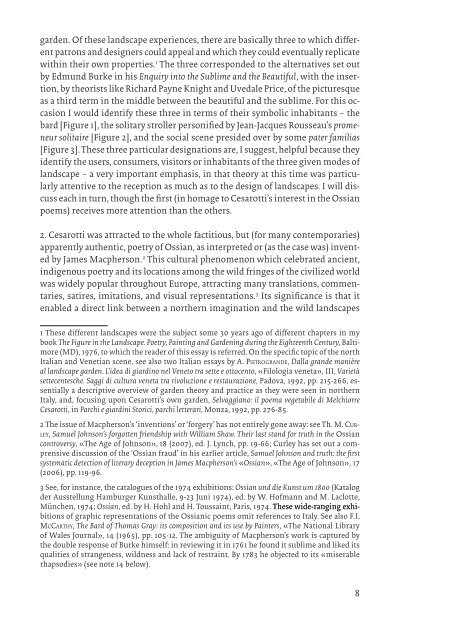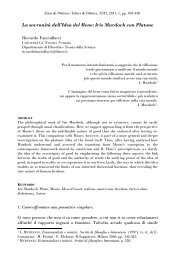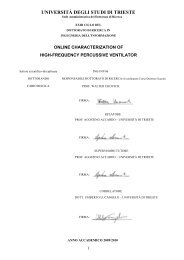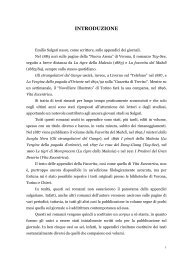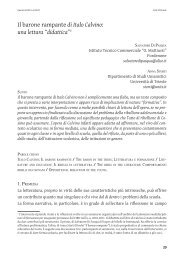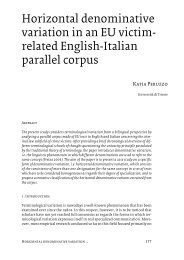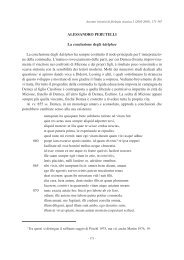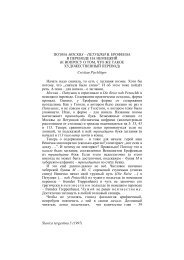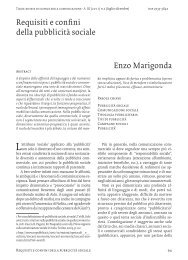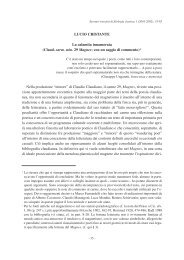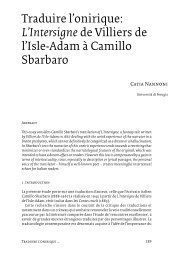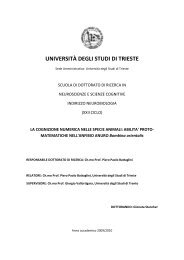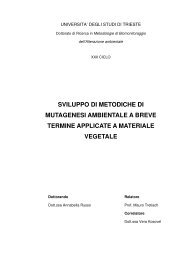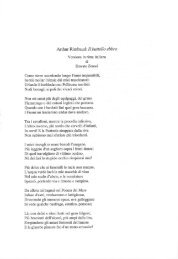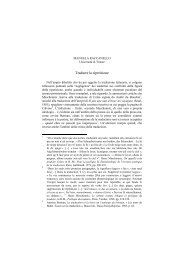Melchiorre Cesarotti e le trasformazioni del paesaggio ... - OpenstarTs
Melchiorre Cesarotti e le trasformazioni del paesaggio ... - OpenstarTs
Melchiorre Cesarotti e le trasformazioni del paesaggio ... - OpenstarTs
You also want an ePaper? Increase the reach of your titles
YUMPU automatically turns print PDFs into web optimized ePapers that Google loves.
garden. Of these landscape experiences, there are basically three to which different<br />
patrons and designers could appeal and which they could eventually replicate<br />
within their own properties. 1 The three corresponded to the alternatives set out<br />
by Edmund Burke in his Enquiry into the Sublime and the Beautiful, with the insertion,<br />
by theorists like Richard Payne Knight and Uveda<strong>le</strong> Price, of the picturesque<br />
as a third term in the midd<strong>le</strong> between the beautiful and the sublime. For this occasion<br />
I would identify these three in terms of their symbolic inhabitants – the<br />
bard [Figure 1], the solitary strol<strong>le</strong>r personified by Jean-Jacques Rousseau’s promeneur<br />
solitaire [Figure 2], and the social scene presided over by some pater familias<br />
[Figure 3]. These three particular designations are, I suggest, helpful because they<br />
identify the users, consumers, visitors or inhabitants of the three given modes of<br />
landscape – a very important emphasis, in that theory at this time was particularly<br />
attentive to the reception as much as to the design of landscapes. I will discuss<br />
each in turn, though the first (in homage to <strong>Cesarotti</strong>’s interest in the Ossian<br />
poems) receives more attention than the others.<br />
2. <strong>Cesarotti</strong> was attracted to the who<strong>le</strong> factitious, but (for many contemporaries)<br />
apparently authentic, poetry of Ossian, as interpreted or (as the case was) invented<br />
by James Macpherson. 2 This cultural phenomenon which ce<strong>le</strong>brated ancient,<br />
indigenous poetry and its locations among the wild fringes of the civilized world<br />
was wi<strong>del</strong>y popular throughout Europe, attracting many translations, commentaries,<br />
satires, imitations, and visual representations. 3 Its significance is that it<br />
enab<strong>le</strong>d a direct link between a northern imagination and the wild landscapes<br />
1 These different landscapes were the subject some 30 years ago of different chapters in my<br />
book The Figure in the Landscape. Poetry, Painting and Gardening during the Eighteenth Century, Baltimore<br />
(MD), 1976, to which the reader of this essay is referred. On the specific topic of the north<br />
Italian and Venetian scene, see also two Italian essays by A. Pietrogrande, Dalla grande manière<br />
al landscape garden. L’idea di giardino nel Veneto tra sette e ottocento, «Filologia veneta», III, Varietà<br />
settecentesche. Saggi di cultura veneta tra rivoluzione e restaurazione, Padova, 1992, pp. 215-266, essentially<br />
a descriptive overview of garden theory and practice as they were seen in northern<br />
Italy, and, focusing upon <strong>Cesarotti</strong>’s own garden, Selvaggiano: il poema vegetabi<strong>le</strong> di <strong>Melchiorre</strong><br />
<strong>Cesarotti</strong>, in Parchi e giardini Storici, parchi <strong>le</strong>tterari, Monza, 1992, pp. 276-85.<br />
2 The issue of Macpherson’s ‘inventions’ or ‘forgery’ has not entirely gone away: see Th. M. Cur<strong>le</strong>y,<br />
Samuel Johnson’s forgotten friendship with William Shaw. Their last stand for truth in the Ossian<br />
controversy, «The Age of Johnson», 18 (2007), ed. J. Lynch, pp. 19-66; Cur<strong>le</strong>y has set out a comprensive<br />
discussion of the ‘Ossian fraud’ in his earlier artic<strong>le</strong>, Samuel Johnson and truth: the first<br />
systematic detection of literary deception in James Macpherson’s «Ossian», «The Age of Johnson», 17<br />
(2006), pp. 119-96.<br />
3 See, for instance, the catalogues of the 1974 exhibitions: Ossian und die Kunst um 1800 (Katalog<br />
der Ausstellung Hamburger Kunsthal<strong>le</strong>, 9-23 Juni 1974), ed. by W. Hofmann and M. Laclotte,<br />
München, 1974; Ossian, ed. by H. Hohl and H. Toussaint, Paris, 1974. These wide-ranging exhiexhibitions of graphic representations of the Ossianic poems omit references to Italy. See also F.I.<br />
MCCarthy, The Bard of Thomas Gray: its composition and its use by Painters, «The National Library<br />
of Wa<strong>le</strong>s Journal», 14 (1965), pp. 105-12. The ambiguity of Macpherson’s work is captured by<br />
the doub<strong>le</strong> response of Burke himself: in reviewing it in 1761 he found it sublime and liked its<br />
qualities of strangeness, wildness and lack of restraint. By 1783 he objected to its «miserab<strong>le</strong><br />
rhapsodies» (see note 14 below).<br />
8


